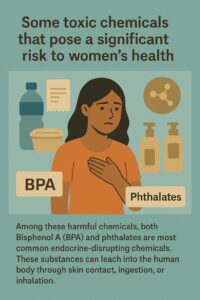IDDRR
Lebanon: Safer futures for women workers
HEAD’s Women’s Chemical Safety Initiative shows that targeted investment in occupational health can protect women workers, safeguard livelihoods, and build resilience against slow-onset disasters, proving that prevention is smarter than recovery.
ORGANISATION
Human Environmental Association for Development – HEAD
LOCATION
Beirut and Mount Lebanon, Lebanon
Investing in women’s safety before disaster strikes
In Lebanon, thousands of women earn their livelihoods in informal sectors such as waste sorting, agriculture, and domestic cleaning. These jobs expose them to harmful chemicals, including Bisphenol A (BPA) and phthalates, substances linked to infertility, endocrine disorders, cancers, and developmental problems in children.
Without intervention, unprotected exposure could trigger a slow-moving public health crisis, straining Lebanon’s fragile health system and deepening economic losses for families who depend on women’s incomes.
HEAD recognised the urgency: investing early in disaster risk reduction (DRR) measures for women’s health could prevent far greater social and economic costs.
Financing prevention, not recovery
Between 2021 and 2023, HEAD implemented the Women’s Chemical Safety Initiative through a mix of international donor support and national contributions. Funding was used to:
- Deliver training workshops for over 350 women workers on chemical hazards, safe handling, and protective alternatives
- Distribute 500 personal protective kits (gloves, masks, safe containers) tailored for agricultural and waste-sector workers
- Pilot safer product alternatives in beauty salons, where BPA-containing plastics and phthalate-laden cosmetics are common
- Advocate for gender-sensitive occupational health policies, aligned with International Labour Organization (ILO) conventions

A graphic that was used during HEAD’s awareness-raising campaign. Credit: HEAD
Impact on lives and livelihoods
The initiative produced tangible results for women in informal work:
- Health protection: Participants reported fewer cases of skin irritation, respiratory discomfort, and dizziness—symptoms previously normalised as “part of the job”
- Economic stability: Safer working conditions reduced absenteeism, securing steadier household incomes
- Awareness ripple effect: Trained women became advocates in their communities, promoting protective practices among peers and family members
- Policy influence: The project brought occupational chemical exposure for women into dialogue with municipal health offices for the first time
One participant shared:
“Before this training, I didn’t know the gloves and masks could protect me from chemicals in my daily work. Now I not only protect myself, but I also tell my colleagues and daughters about it. It gives me strength to continue.”
Preventing loss, building resilience
By directing financing towards prevention rather than reactive measures, HEAD helped avert a slow-moving disaste – one that could have resulted in significant healthcare costs and severe losses in women’s health and livelihoods.
The initiative demonstrates how proactive DRR investment strengthens resilience: protecting workers, empowering women, and showing that funding disaster risk reduction is not an expense but an investment in sustainable development and human dignity.
This International Day for Disaster Risk Reduction, GNDR calls for governments, donors, the private sector and financial institutions to prioritise funding for resilience, not just funding for disasters when they strike.
Header photo: Gudrun Jevne/ILO